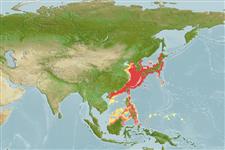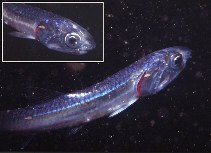個人による観察記録の追加 Fish Watcher
| Native range | All suitable habitat | Point map | Year 2050 |

|
| This map was computer-generated and has not yet been reviewed. |
| Engraulis japonicus AquaMaps Data sources: GBIF OBIS |
Upload your 写真 and ビデオ
Pictures | グーグルの画像Engraulis japonicus
Picture by Zsilavecz, G.
Pictures | グーグルの画像Engraulis japonicus
Picture by Zsilavecz, G.
China country information
Common names:
姑仔, 姑仔, 日本鯷
Occurrence: native
Salinity: marine
Abundance: | Ref:
Importance: highly commercial | Ref: FAO, 1994
Aquaculture: | Ref:
Regulations: | Ref:
Uses: no uses
Comments: Known from Bohai in Liaoning Province (Ref. 47439) and from Yantai City and Qingdao City in Shandong Province (Ref. 47439). Also Ref. 559, 42692, 117610.
National Checklist:
Country Information: https://www.cia.gov/library/publications/resources/the-world-factbook/geos/ch.html
National Fisheries Authority:
Occurrences: Occurrences Point map
Main Ref: Whitehead, P.J.P., G.J. Nelson and T. Wongratana, 1988
National Database:
Occurrence: native
Salinity: marine
Abundance: | Ref:
Importance: highly commercial | Ref: FAO, 1994
Aquaculture: | Ref:
Regulations: | Ref:
Uses: no uses
Comments: Known from Bohai in Liaoning Province (Ref. 47439) and from Yantai City and Qingdao City in Shandong Province (Ref. 47439). Also Ref. 559, 42692, 117610.
National Checklist:
Country Information: https://www.cia.gov/library/publications/resources/the-world-factbook/geos/ch.html
National Fisheries Authority:
Occurrences: Occurrences Point map
Main Ref: Whitehead, P.J.P., G.J. Nelson and T. Wongratana, 1988
National Database:
Common names from other countries
分類 / Names 共通名の | 類義語 | Catalog of Fishes(部類, 種) | ITIS | CoL | WoRMS | Cloffa
> Clupeiformes (Herrings) > Engraulidae (Anchovies) > Engraulinae
Etymology: Engraulis: Greek, eggraulis, -eos = anchovy (Ref. 45335).
More on authors: Temminck & Schlegel.
Etymology: Engraulis: Greek, eggraulis, -eos = anchovy (Ref. 45335).
More on authors: Temminck & Schlegel.
Environment: milieu / climate zone / depth range / distribution range 生態学
海; 海洋回遊性 (Ref. 51243); 深さの範囲 0 - 400 m (Ref. 50550). Temperate; 8°C - 30°C (Ref. 56557); 49°N - 2°N, 105°E - 155°E (Ref. 54432)
分布 国々 | 国連食糧農業機関の区域 | エコシステム | 事件 | Point map | 導入 | Faunafri
Western Pacific: southern Sakhalin Islands, Sea of Japan and Pacific coasts of Japan, and south to almost Canton/Taiwan; rare records (seems to represent stray fishes) off the coasts of Luzon and Western Mindanao, Philippines and from Manado and Ujung Pandang, Sulawesi, Indonesia (Ref. 189).
Length at first maturity / サイズ / 重さ / 年齢
Maturity: Lm 10.5, range 10 - 11 cm
Max length : 18.0 cm TL オス/雌雄の選別がない; (Ref. 56527); common length : 14.0 cm TL オス/雌雄の選別がない; (Ref. 56527); 最大公表体重: 45.00 g (Ref. 56527); 最大記録サイズ: 4 年 (Ref. 56527)
Max length : 18.0 cm TL オス/雌雄の選別がない; (Ref. 56527); common length : 14.0 cm TL オス/雌雄の選別がない; (Ref. 56527); 最大公表体重: 45.00 g (Ref. 56527); 最大記録サイズ: 4 年 (Ref. 56527)
簡単な記述 検索表 | 形態学 | 形態計測学
背面の脊椎 (合計) : 0; 背鰭 (合計) : 12 - 14; 肛門の骨: 0; 臀鰭: 13 - 18. Differs very little from the European anchovy (see E. encrasicolus) and can be identified from that description. Of other anchovies found in the southern part of its distribution, only species of Encrasicholina and Stolephorus are of similar appearance, but all have small spine-like pre-pelvic scutes (usually 2 to 7 scutes). Thryssa have compressed bodies and a keel of scutes along belly.
Occurs in large schools near the surface, mainly in coastal waters but as far out as over 1,000 km from the shore. Tends to move more northward and inshore in spring and summer. Juveniles associate with drifting seaweed (Ref. 12114, 12115). Feeds on copepods, but also on other small crustaceans, molluscan larvae, fish eggs and larvae and diatoms. Marketed fresh and salted, processed into fishmeal and oil (Ref. 12484).
Life cycle and mating behavior 成熟 | 繁殖 | 放精 | 卵 | 生産力 | 幼生
主な参考文献
Upload your references | 参考文献 | コーディネーター | 協力者
Whitehead, P.J.P., G.J. Nelson and T. Wongratana, 1988. FAO Species Catalogue. Vol. 7. Clupeoid fishes of the world (Suborder Clupeoidei). An annotated and illustrated catalogue of the herrings, sardines, pilchards, sprats, shads, anchovies and wolf-herrings. FAO Fish. Synop. 125(7/2):305-579. Rome: FAO. (Ref. 189)
Human uses
水産業: 高い商業の; 水産養殖: 商業; 餌: usually
FAO(水産業: 代謝, 種の外形; publication : search) | FishSource | 私達の周りの海
より多くの情報
Population dynamics
成長のパラメーター
Max. ages / sizes
Length-weight rel.
Length-length rel.
体長組成
Mass conversion
補充
豊度
成長のパラメーター
Max. ages / sizes
Length-weight rel.
Length-length rel.
体長組成
Mass conversion
補充
豊度
Anatomy
カマ
Brain
Otolith
カマ
Brain
Otolith
Physiology
Body composition
Nutrients
酸素消費
水泳形態
泳ぐ速さ
Visual pigments
Fish sound
Diseases & Parasites
Toxicity (LC50s)
Body composition
Nutrients
酸素消費
水泳形態
泳ぐ速さ
Visual pigments
Fish sound
Diseases & Parasites
Toxicity (LC50s)
用具
Bio-Quiz | E-book | 野外観察図鑑 | 検索表 | Length-frequency wizard | 生活史の基盤ツール | 目的のマップ | Classification Tree
| Catch-MSY |
特記事項
XMLをダウンロードして下さい
インターネットの情報源
Aquatic Commons | BHL | Cloffa | BOLDSystems | Websites from users | Check FishWatcher | CISTI | Catalog of Fishes(部類, 種) | DiscoverLife | ECOTOX | Faunafri | Fishtrace | GenBank(ゲノム, ヌクレオチド) | GloBI | GOBASE | | Google Books | Google Scholar | Google | IGFA World Record | MitoFish | 国のデーターベース | Otolith Atlas of Taiwan Fishes | PubMed | Reef Life Survey | Scirus | SeaLifeBase | 生命の木 | Wikipedia(行く, 検索する) | World Records Freshwater Fishing | Zoobank | 動物に関する記録
Estimates based on models
Preferred temperature (Ref. 115969): 8.1 - 23.3, mean 18.4 (based on 139 cells).
Phylogenetic diversity index (Ref. 82804): PD50 = 0.5020 [Uniqueness, from 0.5 = low to 2.0 = high].
Bayesian length-weight: a=0.00398 (0.00272 - 0.00583), b=3.10 (2.98 - 3.22), in cm Total Length, based on LWR estimates for this species & Genus-body shape (Ref. 93245).
栄養段階 (Ref. 69278): 3.1 ±0.1 se; based on diet studies.
回復力 (Ref. 120179): 高い, 15か月以下の倍増期間の最小個体群 (K=1.05; tm=1-2; tmax=3).
Prior r = 0.90, 95% CL = 0.60 - 1.36, Based on 3 full stock assessments.
Fishing Vulnerability (Ref. 59153): Low vulnerability (23 of 100).




